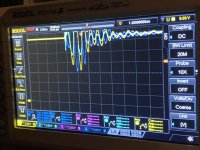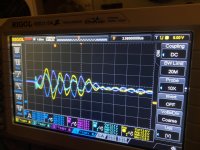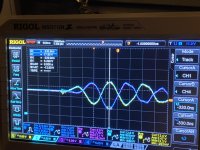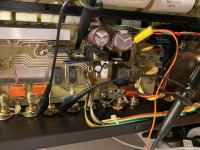It's 1V per div, so when the preamp gets disturbed it's more than 5Vpp. Probe is 10X, but scope compensates for that?
Well that is massive then 🙂 You shouldn't see more than a few millivolts change on the output of the reg, even if the input to the reg alters suddenly.
Have a look at the input pin and make sure the voltage is always above the minimum needed which would typically be about 7 volts. Variation in that voltage is OK but it must never dip below that 7 volt threshold.
Have a look at the input pin and make sure the voltage is always above the minimum needed which would typically be about 7 volts. Variation in that voltage is OK but it must never dip below that 7 volt threshold.
In every case of posters complaints of interference in the UK website I helped on the actual part that caused the interference was replaced or repaired .
That included a large amount of LED lighting which are powered by ---yes--- small SMPS,s , the radiation was so bad that it cut out digital radios /FM radios etc even had one guy sat in his car outside his house and it cut out his car radio .
My question is why don't you replace the PS with one that is not faulty instead of trying to add suppression to your audio equipment ?
Every other UK citizen who posted either took back the rotten LED light bulbs to the shop or repaired other domestic equipment that was emitting radiation either over the air RF or induced via the household mains electricity supply .
Electric light dimmers are notorious for causing the same problems and yes you can now get LED bulbs that can be dimmed.
That included a large amount of LED lighting which are powered by ---yes--- small SMPS,s , the radiation was so bad that it cut out digital radios /FM radios etc even had one guy sat in his car outside his house and it cut out his car radio .
My question is why don't you replace the PS with one that is not faulty instead of trying to add suppression to your audio equipment ?
Every other UK citizen who posted either took back the rotten LED light bulbs to the shop or repaired other domestic equipment that was emitting radiation either over the air RF or induced via the household mains electricity supply .
Electric light dimmers are notorious for causing the same problems and yes you can now get LED bulbs that can be dimmed.
So I've checked on the regulator inputs. It's pretty extreme - they normally have 12V in, but when I plug in the laptop charger there's 15Vpp of noise, and it dips below 5V. See attached images; one is with 2V/2µs, other with 5V/1µS where you see the entire waveform, but less vertical resolution.
There are 10nf ceramics connected between mains and ground, but I guess 1Mhz noise isn't their greatest forte? Would it help if I slapped on some 100nf Y-caps? Or would that be sloppy?
duncan2: This isn't the only laptop charger that causes this - my friend, who owns these, has the same issue as well -- even when he plugs in his vacuum cleaner. This preamp is extremely sensitive.
There are 10nf ceramics connected between mains and ground, but I guess 1Mhz noise isn't their greatest forte? Would it help if I slapped on some 100nf Y-caps? Or would that be sloppy?
duncan2: This isn't the only laptop charger that causes this - my friend, who owns these, has the same issue as well -- even when he plugs in his vacuum cleaner. This preamp is extremely sensitive.
Attachments
I know its sensitive by design I read the information on it , I do not think adding some type of RF filter at the mains input is going to solve your problem , you need complete isolation of the supply .
As an example ,while employed with BT a digital switching telephone system in a business kept on locking up the processor .
It was due to heavy welding equipment achieving the same type of result as your problem .
We wound ferrite filters on every extension outlet ,didn't cure it ,then special screened mains cable was used , still didn't cure it .
It took a very expensive industrial grade mains isolator that not only heavily filtered the incoming mains but provided complete isolation , in other words a crystal frequency controlled separate mains supply.
BT had two choices lose the customer or stump up the cash --they stumped up the cash for this unit .
Several months later the firms CEO dumped BT and got in another company , I didn't hear how they got on.
There are commercial versions of this type of filter but even there you are talking £100,s or $$$ even over £/$ 1000.
BT also had its own large plug in filter and I have one its got high quality inductor,s and capacitors they cost BT £80 each ,that was long ago their new systems can usually cope with bad mains .
RS sold them .
You are looking for a low pass T-type filter and as far as mains electricity is concerned a 100K input impedance on a very sensitive amplifier that I think is "straight through " is asking for trouble but the company are brave in designing this sensitive amplifier .
Impedance "mismatches " involving mains equipment are common but they don't always cause problems .
If you already tried halving the input impedance and it made no difference then try building your own mains conditioner .
It sounds like a CM ( common mode ) noise current problem so here is some info on filters by an electronics engineer.
What Every Electronics Engineer Needs to Know About: Filters - In Compliance Magazine
As an example ,while employed with BT a digital switching telephone system in a business kept on locking up the processor .
It was due to heavy welding equipment achieving the same type of result as your problem .
We wound ferrite filters on every extension outlet ,didn't cure it ,then special screened mains cable was used , still didn't cure it .
It took a very expensive industrial grade mains isolator that not only heavily filtered the incoming mains but provided complete isolation , in other words a crystal frequency controlled separate mains supply.
BT had two choices lose the customer or stump up the cash --they stumped up the cash for this unit .
Several months later the firms CEO dumped BT and got in another company , I didn't hear how they got on.
There are commercial versions of this type of filter but even there you are talking £100,s or $$$ even over £/$ 1000.
BT also had its own large plug in filter and I have one its got high quality inductor,s and capacitors they cost BT £80 each ,that was long ago their new systems can usually cope with bad mains .
RS sold them .
You are looking for a low pass T-type filter and as far as mains electricity is concerned a 100K input impedance on a very sensitive amplifier that I think is "straight through " is asking for trouble but the company are brave in designing this sensitive amplifier .
Impedance "mismatches " involving mains equipment are common but they don't always cause problems .
If you already tried halving the input impedance and it made no difference then try building your own mains conditioner .
It sounds like a CM ( common mode ) noise current problem so here is some info on filters by an electronics engineer.
What Every Electronics Engineer Needs to Know About: Filters - In Compliance Magazine
So I've checked on the regulator inputs. It's pretty extreme - they normally have 12V in, but when I plug in the laptop charger there's 15Vpp of noise, and it dips below 5V. See attached images; one is with 2V/2µs, other with 5V/1µS where you see the entire waveform, but less vertical resolution.
I would say you need to find out why the input to the reg is showing so much disturbance. If the input is fed from a normal transformer and bridge it should not be doing this.
I'd be asking why the reservoir caps are not maintaining the voltage. If the scope is isolated from ground (that is important) then look at the secondary volts from the transformer.
You could also just use another transformer on its own as a means of looking at the voltage and seeing if that glitches.
It seems to be conducted noise and AC input to the regulator isn’t filtered well enough to isolate it from aggresive noise sources like the laptop and when the AC line goes low because of the supply ripple and harmonics the regulator and then the processor drop out. You might want a bigger capcitor on the raw DC supply to the regulator if you can fit it in. A CRC filter would be better, but might be too much of a mod on an expensive piece of equipment
You might want to look at an AC line isolation transformer WITH an electrostatic shield to reduce AC line noise. Some of these can be quite expensive
A less expensive alternative can be a pair of back to back identical split bobbin or EI core transforers with a 20uf Film cap on the secondary. At least twice the AC wattage rating of the preamp. Whatever transformers you can get a reasonable price on. 120 (or 220) primary input and any voltage in the 30 to 60 volt range on the secondary, An X2 rated 20uf safety cap across the secondary, then the same transformer wired backwards to step the voltage back up to 120 Vac (or 220VAC ), basically isolating the AC line. Do NOT use Torroids, they are too wide band a transformer. Keep AC ground continuity from input to output.
You might want to look at an AC line isolation transformer WITH an electrostatic shield to reduce AC line noise. Some of these can be quite expensive
A less expensive alternative can be a pair of back to back identical split bobbin or EI core transforers with a 20uf Film cap on the secondary. At least twice the AC wattage rating of the preamp. Whatever transformers you can get a reasonable price on. 120 (or 220) primary input and any voltage in the 30 to 60 volt range on the secondary, An X2 rated 20uf safety cap across the secondary, then the same transformer wired backwards to step the voltage back up to 120 Vac (or 220VAC ), basically isolating the AC line. Do NOT use Torroids, they are too wide band a transformer. Keep AC ground continuity from input to output.
Last edited:
Since it seems to be occurring in 2 different homes mains wiring/PE won't be the problem or? Still it would be nice if you could confirm using wall outlets with PE and that PE is tested. You described 15Vpp of noise ... which is outrageous (and impossible I might add). Something really is not good by design in that device.
Could you either draw a schematic with building blocks or arrange the schematic? And add some extra pictures of how things are executed in that device otherwise we will run in circles. The problem is not other devices but the ART itself. Any solution to solve it by external means seem counterproductive.
Could you either draw a schematic with building blocks or arrange the schematic? And add some extra pictures of how things are executed in that device otherwise we will run in circles. The problem is not other devices but the ART itself. Any solution to solve it by external means seem counterproductive.
Last edited:
Jean Paul
I agree the ART is the problem, ( and the noisy laptop supply). Maybe get a new laptop supply, ( oversize the current rating compared to the original supply can help), do not get the same supply again.
But there are limited changes to an expensive preamp one can make, maybe a bigger supply cap and some better localised bypassing near the processor is about all. but then the next step is external AC line filtering
I agree the ART is the problem, ( and the noisy laptop supply). Maybe get a new laptop supply, ( oversize the current rating compared to the original supply can help), do not get the same supply again.
But there are limited changes to an expensive preamp one can make, maybe a bigger supply cap and some better localised bypassing near the processor is about all. but then the next step is external AC line filtering
While you're waiting for a schematic..
The noise only occurs when the laptop charger (or other device, it isn't just this charger!) is connected. As mentioned by others, I think it's the inrush current that causes this, not the SMPS by itself. I've attached an image that shows 12.6Vpp - how much it is differs, of course, but has been as large as 20V.
I tried adding a 1µF, 330µF and 1000µF cap before the regulator, but none of them made any real difference. As duncan2 said (I think it was him!), this apparently couldn't be solved by adding a cap. I had to try, though 😱
Interesting! How would two transformers back-to-back differ from a single 1:1?
It should be good; however I haven't done any extensive testing of it. Note however, that this occurs not only in my household, but others as well. Wiring/building is relatively modern (at least modern enough that proper PE was required by law).
If I could travel back to 1995, I would! 😛
My short term plan now is as follows:
1. Connect an isolation transformer in-between
2. Disconnect ground
3. Try isolation transformer + disconnected ground
I have a sick toddler, so everything has to be done in-between. Not sure when I'll get time for a schematic, but I'll do what I can! At least, to try to understand why this happens, and why CJ decided to make it this way.
You described 15Vpp of noise ... which is outrageous (and impossible I might add). Something really is not good by design in that device.
The noise only occurs when the laptop charger (or other device, it isn't just this charger!) is connected. As mentioned by others, I think it's the inrush current that causes this, not the SMPS by itself. I've attached an image that shows 12.6Vpp - how much it is differs, of course, but has been as large as 20V.
It seems to be conducted noise and AC input to the regulator isn’t filtered well enough to isolate it from aggresive noise sources like the laptop and when the AC line goes low because of the supply ripple and harmonics the regulator and then the processor drop out. You might want a bigger capcitor on the raw DC supply to the regulator if you can fit it in. A CRC filter would be better, but might be too much of a mod on an expensive piece of equipment
You might want to look at an AC line isolation transformer WITH an electrostatic shield to reduce AC line noise. Some of these can be quite expensive
I tried adding a 1µF, 330µF and 1000µF cap before the regulator, but none of them made any real difference. As duncan2 said (I think it was him!), this apparently couldn't be solved by adding a cap. I had to try, though 😱
A less expensive alternative can be a pair of back to back identical split bobbin or EI core transforers with a 20uf Film cap on the secondary. At least twice the AC wattage rating of the preamp. Whatever transformers you can get a reasonable price on. 120 (or 220) primary input and any voltage in the 30 to 60 volt range on the secondary, An X2 rated 20uf safety cap across the secondary, then the same transformer wired backwards to step the voltage back up to 120 Vac (or 220VAC ), basically isolating the AC line. Do NOT use Torroids, they are too wide band a transformer. Keep AC ground continuity from input to output.
Interesting! How would two transformers back-to-back differ from a single 1:1?
Just a question: is the device connected to a wall outlet with a known good PE connection?
It should be good; however I haven't done any extensive testing of it. Note however, that this occurs not only in my household, but others as well. Wiring/building is relatively modern (at least modern enough that proper PE was required by law).
My limited change would be to deliver this device back to the manufacturer/distributor 🙂
If I could travel back to 1995, I would! 😛
My short term plan now is as follows:
1. Connect an isolation transformer in-between
2. Disconnect ground
3. Try isolation transformer + disconnected ground
I have a sick toddler, so everything has to be done in-between. Not sure when I'll get time for a schematic, but I'll do what I can! At least, to try to understand why this happens, and why CJ decided to make it this way.
Attachments
An isolation transformer might reduce the noise but it will not remove it.
If you are going in the isolation transformer direction then try a shielded transformer -more info on this a your problem.-
Electrical noise and mitigation – Part 3: Shielding and grounding (cont.), and filtering harmonics | EE Times
The EEtimes is a quality engineering website.
If you are going in the isolation transformer direction then try a shielded transformer -more info on this a your problem.-
Electrical noise and mitigation – Part 3: Shielding and grounding (cont.), and filtering harmonics | EE Times
The EEtimes is a quality engineering website.
Last edited:
The noise only occurs when the laptop charger (or other device, it isn't just this charger!) is connected. As mentioned by others, I think it's the inrush current that causes this, not the SMPS by itself. I've attached an image that shows 12.6Vpp - how much it is differs, of course, but has been as large as 20V.
I tried adding a 1µF, 330µF and 1000µF cap before the regulator, but none of them made any real difference. As duncan2 said (I think it was him!), this apparently couldn't be solved by adding a cap. I had to try, though 😱
I would stick with this. Add your 1000uF cap and then connect the scope directly across cap and see if you observe the same massive spike.
If you do then the next thing I would try would be to clip the probe ground and tip together onto the 1000uF negative (assuming there is no ground conflict with the scope) and see if anything shows connected like this. It should be a flat trace of course with nothing there... but is it? Any spike as you plug the charger in?
So I tried disconnecting ground, by connecting the preamps through my variac. Simply because I don't have any other ground-defeat peripheral immediately available (not something I usually do!). Not sure if the variac ends up filtering out stuff, but it worked like a charm. No issues whatsoever, not a single blip on the scope.
So either it's a grounding issue, or my variac filters it out (I have a B&O RT12).
Sadly, right after this my laptop charger broke.. as my chair got tangled in the cable and pulled the laptop down from the table. I'm so.. angry I have no words. Whatever happened to magsafe. Anyway... so the connector's bent, and I need a new charger. And something else to trip the preamp with. Thankfully, it's my work PC (= high quality Dell), so it doesn't mind a blow or two.
I attached a few pictures of the preamp innards, if it's of any interest. Nice Conrad Johnson teflon caps there..
So either it's a grounding issue, or my variac filters it out (I have a B&O RT12).
Sadly, right after this my laptop charger broke.. as my chair got tangled in the cable and pulled the laptop down from the table. I'm so.. angry I have no words. Whatever happened to magsafe. Anyway... so the connector's bent, and I need a new charger. And something else to trip the preamp with. Thankfully, it's my work PC (= high quality Dell), so it doesn't mind a blow or two.
I attached a few pictures of the preamp innards, if it's of any interest. Nice Conrad Johnson teflon caps there..

Attachments
You mention it looks like a grounding issue but then you mean PE or Audio GND ? Do you know what voltages the power transformer has? I still have a suspicion.
I would only separate Audio GND from PE but leave PE connected to the casing for testing. I know it is uncommon in England but try out lifting Audio GND from PE with either the 10 Ohm resistor, Graetz bridge or CL60 trick. I have seen devices with direct connections between Audio GND and PE that had unwanted phenomenons. It creates more issues than it solves IMO.
I would only separate Audio GND from PE but leave PE connected to the casing for testing. I know it is uncommon in England but try out lifting Audio GND from PE with either the 10 Ohm resistor, Graetz bridge or CL60 trick. I have seen devices with direct connections between Audio GND and PE that had unwanted phenomenons. It creates more issues than it solves IMO.
Last edited:
So it is what I posted Common Mode Noise ( via the ground ).
Differential (Normal) Mode Noise and Common Mode Noise-Causes and Measures | Basic Knowledge | ROHM TECH WEB: Technical Information Site of Power Supply Design
Differential (Normal) Mode Noise and Common Mode Noise-Causes and Measures | Basic Knowledge | ROHM TECH WEB: Technical Information Site of Power Supply Design
Audio ground is separated from PE by ~100ohm. PE is directly connected to transformer center tap (secondary), which is also the return. I was a bit puzzled by this, but I assume this is normal? Neutral and ground isn't necessarily the same, at least where I live. But this is a bit outside my expertise. It's late and my brain is farting heavily, so apologies in advance..
Last edited:
duncan2, btw: Thank you for that article. I never got around to saying it, but it was very interesting and I learned a great deal 🙂
Audio ground is separated from PE by ~100ohm. PE is directly connected to transformer center tap (secondary), which is also the return. I was a bit puzzled by this, but I assume this is normal? Neutral and ground isn't necessarily the same, at least where I live. But this is a bit outside my expertise. It's late and my brain is farting heavily, so apologies in advance..
No that is not normal. At least not when Audio GND is lifted with 100 Ohm 🙂
- Home
- Amplifiers
- Power Supplies
- Conrad Johnson preamp hiccups on line noise




